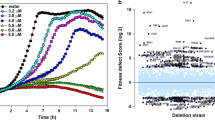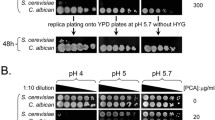Abstract
A yeast cDNA expression library was screened to identify genes and cellular processes that influence fungal sensitivity to a plant antimicrobial peptide. A plasmid-based, GAL1 promoter-driven yeast cDNA expression library was introduced into a yeast genotype susceptible to the antimicrobial peptide MiAMP1 purified from Macadamia integrifolia. Following a screen of 20,000 cDNAs, three yeast cDNAs were identified that reproducibly provided transformants with galactose-dependent resistance to MiAMP1. These cDNAs encoded a protein of unknown function, a component (VMA11) of the vacuolar H+-ATPase and a component (cytochrome c oxidase subunit VIa) of the mitochondrial electron transport chain, respectively. To identify genes that increased sensitivity to MiAMP1, the yeast cDNA expression library was introduced into a yeast mutant with increased resistance to MiAMP1. From 11,000 cDNAs screened, two cDNA clones corresponding to a ser/thr kinase and a ser/thr phosphatase reproducibly increased MiAMP1 susceptibility in the mutant in a galactose-dependent manner. Deletion mutants were available for three of the five genes identified but showed no change in their sensitivity to MiAMP1, indicating that these genes could not be detected by screening of yeast deletion mutant libraries. Yeast cDNA expression library screening therefore provides an alternative approach to gene deletion libraries to identify genes that can influence the sensitivity of fungi to plant antimicrobial peptides.





Similar content being viewed by others
References
Altschul SF, Madden TL, Schäffer AA, Zhang J, Zhang Z, Miller W, Lipman DJ (1997) Gapped BLAST and PSI-BLAST: a new generation of protein database search programs. Nucleic Acids Res 25:3389–3402
Antuch W, Güntert P, Wüthrich K (1996) Ancestral βγ-crystallin precursor structure in a yeast killer toxin. Nat Struct Biol 3:62–665
Asiegbu FO, Choi W, Li G, Nahalkova J, Dean RA (2003) Isolation of a novel antimicrobial peptide gene (Sp-AMP) homologue from Pinussylvestris (Scots pine) following infection with the root rot fungus Heterobasidion annosum. FEMS Microbiol Letts 228:27–31
Bairoch A, Apweiler R (2000) The SWISS-PROT protein sequence database and its supplement TrEMBL in 2000. Nucleic Acids Res 28:45–48
Campos-Olivas R, Horr I, Bormann C, Jung G, Gronenborn AM (2001) Solution structure, backbone dynamics and chitin binding of the anti-fungal protein from Streptomyces tendae TU901. J Mol Biol 308:65–782
Davidson J, Ekramoddoullah AKM (1997) Analysis of bark proteins in blister rust-resistant and susceptible western white pine (Pinus monticola). Tree Physiol 17:663–669
Geitz D, St Jean A, Woods RA, Schiestl RH (1992) Improved method for high efficiency transformation of intact yeast cells. Nucleic Acids Res 20:1425
Hancock REW, Scott MG (2000) The role of antimicrobial peptides in animal defenses. Proc Natl Acad Sci USA 97:8856–8861
He CH, Masson JY, Ramotar D (1996) Functional mitochondria are essential for Saccharomyces cerevisiae cellular resistance to bleomycin. Curr Genet 30:279–283
Hirata R, Graham LA, Takatsuki A, Stevens TH, Anraku Y (1997) VMA11 and VMA16 encode second and third proteolipid subunits of the Saccharomyces cerevisiae vacuolar membrane H+-ATPase. J Biol Chem 272:4795–4803
Hoffman CS, Winston F (1987) A ten-minute DNA preparation from yeast efficiently releases autonomous plasmids for transformation of Escherichia coli. Gene 57:267–272
Horton P, Nakai K (1997) Better prediction of protein cellular localization sites with the k nearest neighbors classifier. Intell Syst Mol Biol 5:147–152
Hunter T, Plowman GD (1997) The protein kinase of budding yeast: six score and more. Trends Biochem Sci 22:18–22
Ibeas JI, Yun DJ, Damsz B, Narasimhan ML, Uesono Y, Ribas JC, Lee H, Hasegawa PM, Bressan RA, Pardo JM (2001) Resistance to the plant PR-5 protein osmotin in the model fungus Saccharomyces cerevisiae is mediated by the regulatory effects of SSD1 on cell wall composition. Plant J 25:271–280
Jiang L, Whiteway M, Ramos CW, Rodriguez-Medina JR, Shen S-H (2002) The YHR076Wgene encodes a type 2C protein phosphatase and represents the seventh PP2 gene in budding yeast. FEBS Letts 527:323–325
Kazan K, Rusu A, Marcus JP, Goulter KC, Manners JM (2002) Enhanced quantitative resistance to Leptosphaeria maculans conferred by expression of a novel antimicrobial peptide in canola (Brassica napus L.). Mol Breeding 10:63–70
Kimura T, Kitamoto N, Kito Y, Iimura Y, Shirai T, Komiyama T, Furuichi Y, Sakka K, Ohmiya K (1997) A novel yeast gene, RHK1, is involved in the synthesis of the cell wall receptor for the HM-1 killer toxin that inhibits β-1,3-glucan synthesis. Mol Gen Genet 254:139–147
Klein P, Kanehisa M, DeLisi C (1985) The detection and classification of membrane-spanning proteins. Biochim Biophys Acta 815:468–476
Liao X, Butow RA (1993) RTG1 and RTG2: two yeast genes required for a novel path of communication from mitochondria to the nucleus. Cell 72:61–71
Marcus JP, Goulter KC, Green JL, Harrison SJ, Manners JM (1997) Purification, characterisation and cDNA cloning of a novel antimicrobial peptide from Macadamia integrifolia. Eur J Biochem 244:743–749
Marcus JP, Green JL, Goulter KC, Manners JM (1999) A family of antimicrobial peptides is produced by processing of a 7S globulin protein in Macadamia integrifolia. Plant J 19:699–710
McManus AM, Nielsen KJ, Marcus JP, Harrison SJ, Green JL, Manners JM, Craik DJ (1999) MiAMP1, a novel protein from Macadamia integrifoliaadopts a greek key β-barrel fold unique amongst plant antimicrobial proteins. J Mol Biol 293:629–638
Narasimhan ML, Damsz B, Coca MA, Ibeas JI, Yun D-J, Pardo JM, Hasegawa PM, Bressan RA (2001) A plant defense response effector induces microbial apoptosis. Mol Cell 8:921–930
Nourani A, Wesolowki-Louvel M, Delaveau T, Jacq C, Delahodde A (1997) Multiple-drug-resistance phenomenon in yeast Saccharomyces cerevisiae: involvement of two hexose transporters. Mol Cell Biol 17:5453–5460
Ohki S, Kariya E, Hiraga K, Wakamiya A, Isobe T, Oda K, Kainosho M (2001) NMR structure of Streptomyces killer toxin-like protein, SKLP: further evidence for the wide distribution of single-domain β γ-crystallin superfamily proteins. J Mol Biol 305:109–120
Ohno A, Tate S, Seeramm SS, Hiraga K, Swindells MB, Oda K, Kainosho M (1998) NMR structure of the Streptomyces metalloproteinase inhibitor, SMPI, isolated from Streptomyces nigrescens TK-23: another example of an ancestral βγ-crystallin precursor structure. J Mol Biol 282:421–433
Pagé N, Gérard-Vincent M, Ménard P, Beaulieu M, Azuma M, Dijkgraaf GJP, Li H, Marcoux J, Nguyen T, Dowse T, Sdicu A, Bussey H (2003) A Saccharomyces cerevisiae genome-wide mutant screen for altered sensitivity to K1 killer toxin. Genetics 163:875–894
Parsons AB, Brost RL, Ding H, Li Z, Zhang C, Sheikh B, Brown GW, Kane PM, Hughes TR, Boone C (2004) Integration of chemical-genetic and genetic interaction data links bioactive compounds to cellular target pathways. Nat Biotechnol 22:62–69
Ramos CW, Güldener U, Klein S, Hegemann JH, Gonzalez S, RodrÍguez-Medina JR (2000) Molecular analysis of the Saccharomyces cerevisiae YHR076w gene. IUBMB Life 50:371–377
Rosinke B, Renner C, Mayr E-M, Jaenicke R, Holak TA (1997) Ca2+ -loaded spherulin 3a from Physarum polycephalum adopts the prototype γ-crystallin fold in aqueous solution. J Mol Biol 271:645–655
Shih CK, Kwong J, Montalvo E, Neff N (1990) Expression of a proteolipid gene from a high-copy-number plasmid confers trifluoperazine resistance to Saccharomyces cerevisiae. Mol Cell Biol 10:3397–3404
Smith FW, Hawkesford MJ, Prosser IM, Clarkson DT (1995) Isolation of a cDNA from Saccharomyces cerevisiae that encodes a high affinity sulphate transporter at the plasma membrane. Mol Gen Genet 247:709–715
Stephens C, Kazan K, Goulter KC, Maclean DJ, Manners JM (2005) The mode of action of the plant antimicrobial peptide MiAMP1 differs from that of its structural homologue, the yeast killer toxin WmKT. FEMS Microbiol Lett 243:205–210
Thevissen K, Cammue BP, Lemaire K, Winderickx J, Dickson RC, Lester RL, Ferket KK, Van Even F, Parret AH, Broekaert WF (2000) A gene encoding a sphingolipid biosynthesis enzyme determines the sensitivity of Saccharomyces cerevisiae to an antifungal plant defensin from dahlia (Dahlia merckii). Proc Natl Acad Sci USA 97:9531–9536
Thevissen K, Ferket KKA, Francois IEJA, Cammue BPA (2003a) Interactions of antifungal plant defensins with fungal membrane components. Peptides 24:1705–1712
Thevissen K, Francois IEAJA, Takemoto JY, Ferket KKA, Meert EMK, Cammue BPA (2003b) DmAMP1, an antifungal plant defensin from dahlia (Dahlia merckii), interacts with sphingolipids from Saccharomyces cerevisiae. FEMS Microbial Letts 226:169–173
Thevissen K, Warnecke DC, Francois IEJA, Leipelt M, Heinz E, Ott C, Zahringer U, Thomma BPHJ, Ferket KKA, Cammue BPA (2004) Defensins from insects and plants interact with fungal glucosylceramides. J Biol Chem 279:3900–3905
Vagnoli P, Bisson LF (1998) The SKS1 gene of Saccharomyces cerevisiae is required for long-term adaptation of snf3 null strains to low glucose. Yeast 14:359–369
Von Heijne G, Gavel Y (1988) Topogenic signals in integral membrane proteins. Eur J Biochem 174:671–678
Winzeler EA, Shoemaker DD, Astromoff A, Liang H, Anderson K, Andre B, Bangham R, Benito R, Boeke JD, Bussey H, Chu AM, Connelly C, Davis K, Dietrich F, Whelen Dow S, El Bakkoury M, Foury F, Friend SH, Gentalen E, Giaever G, Hegemann JH, Jones T, Laub M, Liao H, Liebundguth N, Lockhart DJ, Lucau-Danila, M’Rabet AN, Menard P, Mittmann M, Pai C, Rebischung C, Revuelta JL, Riles L, Roberts CJ, Ross-MacDonald P, Scherens B, Sookhai-Mahadeo S, Storms RK, Véronneau S, Voet M, Volckaert G, Ward TR, Wysocki R, Yen GS, Yu K, Zimmermann K, Philippsen P, Johnston M, Davis RW (1999) Functional characterization of the S. cerevisiaegenome by gene deletion and parallel analysis. Science 285:901–906
Yabe T, Yamada-Okabe T, Kasahara S, Furuichi Y, Nakajima T, Ichishima E, Arisawa M, Yamada-Okabe H (1996) HKR1 encodes a cell surface protein that regulates both cell wall β-glucan synthesis and budding pattern in the yeast Saccharomyces cerevisiae. J Bacteriol 178:477–483
Yun DJ, Zhao Y, Pardo JM, Narasimhan ML, Damsz B, Lee H, Abad LR, D’Urzo MP, Hasegawa PM, Bressan RA (1997) Stress proteins on the yeast cell surface determine resistance to osmotin, a plant antifungal protein. Proc Natl Acad Sci USA 94:7082–7087
Yun D-J, Ibeas JI, Lee H, Coca MA, Narasimhan ML, Uesono Y, Hasegawa PM, Pardo JM, Bressan RA (1998) Osmotin, a plant antifungal protein subverts signal transduction to enhance fungal cell susceptibility. Mol Cell 1:807–817
Acknowledgements
This study was funded by an Australian Postgraduate Research Award to C.S. and a Postgraduate Scholarship from the Sugar Research and Development Corporation to S.J.H.
Author information
Authors and Affiliations
Corresponding author
Additional information
Communicated by J. Heitman
Rights and permissions
About this article
Cite this article
Stephens, C., Harrison, S.J., Kazan, K. et al. Altered fungal sensitivity to a plant antimicrobial peptide through over-expression of yeast cDNAs. Curr Genet 47, 194–201 (2005). https://doi.org/10.1007/s00294-005-0562-8
Received:
Revised:
Accepted:
Published:
Issue Date:
DOI: https://doi.org/10.1007/s00294-005-0562-8




